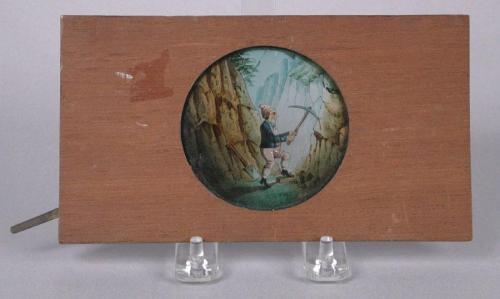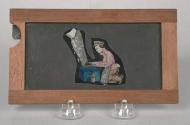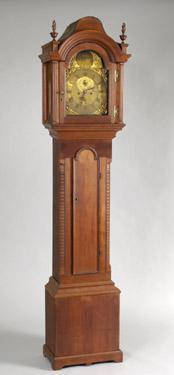Lantern Slides
PhotographerPhotographed by
Unknown
Date1850-1920
MediumWood, glass, brass
DimensionsPrimary Dimensions (height x width): 3 15/16 x 8 3/8 x 3/8in. (10 x 21.2 x 1cm) and smaller
ClassificationsGraphics
Credit LineGift of G. Fox & Co.
Object number1949.2.16-.22
DescriptionSeven animated magic lantern slides in wood frames. The picture on the slide changes when either a lever or piece of glass is moved.
Lever slide (.16): Round piece of glass with a hand-colored picture of a man wearing a hat in a mountain scene. A second piece of glass behind the first is painted with the man's arms holding a pick-ax. A shovel is leaning up against some rocks behind him. When the lever is moved, the second piece of glass, surrounded by the brass that is part of the lever, shows his arms with the pick-ax moving up and down appearing to be digging into the mountain. Two small nails hold the glass with the animation into the frame, and allow movement. The brass lever has a range of motion limited by a cut-out in the wood frame.
Slipping slide (.17): Rectangular glass with a hand-painted image of a shoe-shine boy wearing a hat and apron, kneeling by a box with a booted foot resting on it. The area around the main picture on the primary glass has been painted black to mask out the area around the main scene. A second piece of glass is hand painted with the boy's arm holding a brush. When the second piece of glass is moved back and forth, the arm with the brush moves, appearing to shine the boot. Two small nails hold the glass in place, and a third small nail at one end limits the range of motion of the animation glass. There is a cut-out at the edge of the wood frame, and two pieces of black paper adhered to the animation glass for someone to grab the glass and slide it back and forth. Two thin spacers at the top and bottom edges keep the two pieces of glass from rubbing.
Lever slide (.18): A square piece of glass in a rectangular wood frame is hand-painted with an image of a juggler with knives. The area around the main picture on the primary glass has been painted black to mask out the area around the main scene. When the lever is moved, a second piece of glass with black paint masks the juggler's arms and knives, and reveals a second set of arms and knives, making them appear to move. A nail in wood frame limits the motion. The animation glass is framed with brass and attached to the wood frame with small brass screws.
Slipping slide (.19): A rectangular piece of glass with a hand painted image of a man riding a pig. The area around the main picture on the primary glass has been painted black to mask out the area around the main scene. When a second piece of glass with black paint masking is moved, it reveals an image of the man falling off of the pig. A small nail at the bottom is partially holding the second piece of glass in the frame. A second nail at the top is missing, and scotch tape has been used to hold the glass to the wood frame. Handwritten in pencil at the top edge, "Boy riding a pig"
Slipping slide (.20): A rectangular piece of glass with a hand painted image of a man wearing a hat with a scarf tied around his chin seated on a bench. He holds a pop-gun with a string tied to one of his teeth. The area around the main picture on the primary glass has been painted black to mask out the area around the main scene. When a second piece of glass with black paint masking is moved, it reveals the pop-gun having been fired, and the tooth hanging at the end of the string after having been pulled out. The second piece of glass of glass is held into the frame by two small nails. Handwritten in pencil at the bottom edge, "DENTIST".
Slipping slide (.21): A rectangular piece of glass with an image of a boy holding a hat and running towards a butterfly and a rose bush in a wood frame. When a second piece of glass with black masking paint is pulled it hides one arm, butterfly and hat, and reveals the arm holding the hat appearing to have caught the butterfly. Small nails on the top and bottom edges hold the glass in place, and part of the wood frame cut on an angle keeps the second glass piece from sliding all the way out. Inscribed on the bottom edge in ink, "Boy & butterfly"
Slipping slide (.22): A round piece of glass (possibly two pieces) in a rectangular wood frame with round opening. The glass has a wreath with roses and other flowers. In the center of the wreath are the words, "GOOD / NIGHT". When a second piece of glass with an area of black masking paint is moved, the words are covered over. A printed label on the bottom edge of the slide reads, "CLASS XVII. DISSOLVING PICTURES./ 10. 'GOOD NIGHT;' in a Wreath of Flowers." Handwritten on the same label, "3.75"
Lever slide (.16): Round piece of glass with a hand-colored picture of a man wearing a hat in a mountain scene. A second piece of glass behind the first is painted with the man's arms holding a pick-ax. A shovel is leaning up against some rocks behind him. When the lever is moved, the second piece of glass, surrounded by the brass that is part of the lever, shows his arms with the pick-ax moving up and down appearing to be digging into the mountain. Two small nails hold the glass with the animation into the frame, and allow movement. The brass lever has a range of motion limited by a cut-out in the wood frame.
Slipping slide (.17): Rectangular glass with a hand-painted image of a shoe-shine boy wearing a hat and apron, kneeling by a box with a booted foot resting on it. The area around the main picture on the primary glass has been painted black to mask out the area around the main scene. A second piece of glass is hand painted with the boy's arm holding a brush. When the second piece of glass is moved back and forth, the arm with the brush moves, appearing to shine the boot. Two small nails hold the glass in place, and a third small nail at one end limits the range of motion of the animation glass. There is a cut-out at the edge of the wood frame, and two pieces of black paper adhered to the animation glass for someone to grab the glass and slide it back and forth. Two thin spacers at the top and bottom edges keep the two pieces of glass from rubbing.
Lever slide (.18): A square piece of glass in a rectangular wood frame is hand-painted with an image of a juggler with knives. The area around the main picture on the primary glass has been painted black to mask out the area around the main scene. When the lever is moved, a second piece of glass with black paint masks the juggler's arms and knives, and reveals a second set of arms and knives, making them appear to move. A nail in wood frame limits the motion. The animation glass is framed with brass and attached to the wood frame with small brass screws.
Slipping slide (.19): A rectangular piece of glass with a hand painted image of a man riding a pig. The area around the main picture on the primary glass has been painted black to mask out the area around the main scene. When a second piece of glass with black paint masking is moved, it reveals an image of the man falling off of the pig. A small nail at the bottom is partially holding the second piece of glass in the frame. A second nail at the top is missing, and scotch tape has been used to hold the glass to the wood frame. Handwritten in pencil at the top edge, "Boy riding a pig"
Slipping slide (.20): A rectangular piece of glass with a hand painted image of a man wearing a hat with a scarf tied around his chin seated on a bench. He holds a pop-gun with a string tied to one of his teeth. The area around the main picture on the primary glass has been painted black to mask out the area around the main scene. When a second piece of glass with black paint masking is moved, it reveals the pop-gun having been fired, and the tooth hanging at the end of the string after having been pulled out. The second piece of glass of glass is held into the frame by two small nails. Handwritten in pencil at the bottom edge, "DENTIST".
Slipping slide (.21): A rectangular piece of glass with an image of a boy holding a hat and running towards a butterfly and a rose bush in a wood frame. When a second piece of glass with black masking paint is pulled it hides one arm, butterfly and hat, and reveals the arm holding the hat appearing to have caught the butterfly. Small nails on the top and bottom edges hold the glass in place, and part of the wood frame cut on an angle keeps the second glass piece from sliding all the way out. Inscribed on the bottom edge in ink, "Boy & butterfly"
Slipping slide (.22): A round piece of glass (possibly two pieces) in a rectangular wood frame with round opening. The glass has a wreath with roses and other flowers. In the center of the wreath are the words, "GOOD / NIGHT". When a second piece of glass with an area of black masking paint is moved, the words are covered over. A printed label on the bottom edge of the slide reads, "CLASS XVII. DISSOLVING PICTURES./ 10. 'GOOD NIGHT;' in a Wreath of Flowers." Handwritten on the same label, "3.75"
Collections
Status
Not on view
















